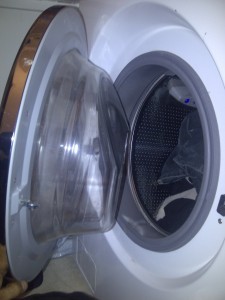One of the most common house calls our appliance repair guys get is due to foul-smelling washing machines. Front load washers are notorious for producing musty, mildew smells.
The truth is, it usually is a mold or mildew problem within the machine itself. Sometimes you can clean out the mold or mildew problem enough that the odor disappears. Sometimes the problem is so severe that it’s just hazardous to your health to continue keeping such a mess inside your house. In that case, it’s best to just get rid of it.
You should always call the manufacturer first about such problems because your machine may still be under warranty. They can send a “repair man” out to your place who will give you some tips and, if he actually does his job, will open up the unit to show you how to clean out the filter or trap. If it is not under warranty, you can call our service adviser, and our North Charleston technicians will be happy to help you fix the problem.
In some cases, when the manufacturer sees fit, the unit may be replaced, or they’ll send you a new seal. Do not offer to buy the seal. They usually range from a couple of hundred dollars. Don’t go that route right off the bat. Check if something can be done before you dish out another nice chunk of money. You can call us to install it for you. Sadly, the chances that the mold from the seal has spread throughout the tubing and inner workings of the unit are very high. Replacing ONE part isn’t likely to fix the problem in the long run. You’d have to continue to replace the part over and over.
There are some lawsuits going through about these washers, too, depending on what brand and model you have. Rubber seals produce a specific type of mold that not much can kill completely. After you drop quite a bit of money on one of these machines, you don’t expect it to be overrun with mold within a few months of use. So, you might want to check into that.
Try to look up the make and model of your unit online and see if it’s possible to reach the trap or filter. UNPLUG THE UNIT BEFORE REMOVING ANYTHING! This is usually in the front of the washer, below the door. It’s typically screwed together with two or three small screws. From there you’ll see a white colored knob that you can twist off (depending on what brand and model you have). There is some water in that area that should be drained regularly.
Sometimes coins, baby socks, dollar bills, and other pieces of lint and tidbits from pockets get lodged in this area. Be warned, they may be moldy, black, or brown at this point if you’ve never cleaned out the filter before. You want to remove the debris and clean this area well with some bleach water. Do this once a week for the first month, and then, from here on out, once a month. If you aren’t into the whole bleach option (understandable; bleach is horrible for the environment), then you can soak the stuff in hot water and vinegar. You may need to soak parts overnight in the water/vinegar solution.
If you haven’t already, pull out the tray for your detergent and scrub it down in the same solution listed above (bleach water or vinegar water). Sometimes mold can actually grow in that little compartment, and a good scrubbing once a week for the first month, and once a month from then on out, can help remove that problem entirely.
How to clean front load washer

Clean the seal in the front area of your washer with a strong vinegar solution. Scrub hard. Elbow grease! In addition, scrub the clear door down really, really well.
Rinse out the washer with vinegar. Pour a couple of cups of vinegar into the detergent and fabric soften trays. Set the washer on the longest, hottest cycle with a double rinse. Turn it on and let the washer do its thing.
Cycle your washer with hot water and vinegar once a week for the first month, and then once a month there on after.
Always leave the compartment for the detergent and softener opened after a wash to help it air out and dry properly. Always leave the door open after a wash to help it dry out and breathe, too.
Try to avoid using too much bleach if you decide to go that route. Too much bleach can easily damage the seal. Instead of bleach, an alternative is sanitizing most, if not all, of the washer with vinegar. Vinegar is cheap and less harmful.
Need some help? Fill out the form on our main page, and one of our customer service representatives will contact you to schedule an appointment with our specialist.





